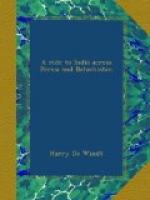If the streets of Ispahan are narrow, those of Djulfa, the Armenian settlement, can only be described as almost impassable, for, although the widest are barely ten feet across, quite a third of this space is taken up by the deep ditch, or drain, lined with trees, by which all are divided. But the town, or settlement, is as clean and well-kept as Ispahan itself is the reverse, which is saying a great deal.
Djulfa is called after the Armenian town of that name in Georgia, the population of which, for commercial reasons, was removed to this place by Shah Abbas in A.D. 1603. Djulfa, near Ispahan, was once a large and flourishing city, with as many as twenty district parishes, and a population of sixty thousand souls, now dwindled down to a little over two thousand, the greater part of whom live in great want and poverty. The city once possessed as many as twenty churches, but most of these are now in ruins. The cathedral, however, is still standing, and in fair preservation. It dates from A.D. 1655. There is also a Roman Catholic colony and church. The latter stands in a large garden, celebrated for its quinces and apricots. Lastly, the English Church Missionary Society have an establishment here under the direction of the Rev. Dr. Bruce, whose good deeds during the famine are not likely to be forgotten by the people of Ispahan and Djulfa, whatever their creed or religion. The trade of Djulfa is insignificant, although there is a large amount of wine and arak manufactured there, and sold “under the rose” to the Ispahanis. The production of the juice of the grape is somewhat primitive. During the season (September and October) the grapes are trodden out in a large earthenware pan, and the whole crushed mass, juice and all, is stowed away in a jar holding from twenty to thirty gallons, a small quantity of water being added to it. In a few days fermentation commences. The mass is then stirred up every morning and evening with sticks for ten or twenty days. About this period the refuse sinks to the bottom of the jar, and the wine is drawn off and bottled. In forty days, at most, it is fit to drink.
My time at Ispahan was limited, so much so that I was not able to pay a visit to the “Shaking minarets,” about six miles off. These mud towers, of from twenty to thirty feet high, are so constructed that a person, standing on the roof of the building between the two, can, by a slight movement of his feet, cause them to vibrate.
I spent most of my time, as usual, strolling about the least-frequented parts of the city, or in the cool, picturesque gardens of the Madrassa. The people of Teheran, and other Persian cities, are generally civil to strangers; but at Ispahan the prejudice against Europeans is very strong, and I more than once had to make a somewhat hasty exit from some of the lower quarters of the city.
Mrs. S——, the wife of a telegraph official, was stabbed by some miscreants while walking in broad daylight on the outskirts of the town, a few months before my visit. The offenders were never caught; probably, as Ispahan is under the jurisdiction of the Zil-i-Sultan, were never meant to be.




